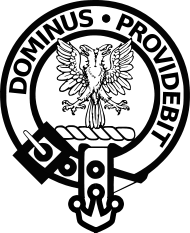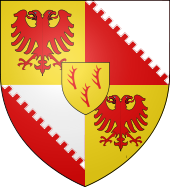- Clan Boyle
-
Clan Boyle Crest badge 
Crest: A double headed eagle displayed, parted per pale embattled Gules and Argent Motto: Dominus providebit Profile Region Lowlands District North Ayrshire Chief

The Rt. Hon. Patrick Boyle The 10th Earl of Glasgow Seat Kelburn Castle Clan Boyle is a Scottish clan from Ayrshire in Scotland. There is also an Irish sept of the O'Neill Clan of the name O'Boyle or in Irish Ó Baoighill. The O'Boyles are one of three clans who shared the leadership of the North West of Ireland, specifically Co. Donegal.
Contents
Origins of Scottish Clan Boyle
There is little doubt that the de Beauvilles (or de Boyville) came to Britain following the Norman conquest of 1066. They settled in Wales and Cumberland initially, though some of the Welsh line later travelled to Ireland and are the ancestors of the Earls of Cork and Shannon.
In 1124 Hugh de Morvile was granted the lands of Cunningham and Largs from King David, part of which was subdivided and gifted to his relatives. The de Boyvilles thus gained the lands of Kelburn. The male line failed in 1196 and the family property passed to the Lords of Galloway. However, in 1234 that male line also failed and the land passed to the Crown.
The family aided Alexander III in repelling Viking invaders in 1263 at the Battle of Largs. and the lands of Kelburn were returned to the family. In 1291 Henry de Boyville was keeper of the Castles of Dumfries, Wigton and Kirkcudbright.
Wars of Scottish Independence
Richard and Robert de Boyvil appear on the Ragman Rolls as barons submitting to Edward I of England. However the Boyles fought at the Battle of Bannockburn in 1314 in support of Robert I of Scotland.
15th and 16th centuries
The Clan Boyle fought at the Battle of Sauchieburn for James III. The family lands were forfeited following the battle of Sauchieburn but were restored by James IV.
During the Anglo-Scottish Wars the Boyles also fought at the Battle of Pinkie Cleugh in 1547 under the regent, the Earl of Arran.
The family supported Mary, Queen of Scots, and later in the 17th century they supported Charles I.
17th and 18th centuries
The Boyles suffered badly for their allegiances. However, the family began its restoration in 1681 when John Boyle of Kelburn was elected as Commissioner of Parliament. John's eldest son, David Boyle also became a Commissioner of Parliament and Privy Counsellor. In 1699 David was raised to the Peerage as Lord Boyle of Kelburn, and then in 1703 was created Earl of Glasgow. After the Union he sat as a Scottish Representative peer from 1707 to 1710. He was appointed Lord High Commissioner to the General Assembly of the Church of Scotland in 1706 and in 1707 to 1710. He was also Lord Clerk Register prior to 1714. A staunch supporter of the Hanoverian cause, he raised and armed troops at his own expense when the 'Old Pretender' raised the clans against the Crown.
John Boyle, 3rd Earl of Glasgow was a military man, wounded at the Battle of Fontenoy in 1745 and again at the Battle of Lauffeld in 1747. He, like the 1st Earl, was appointed Lord High Commissioner to the General Assembly of the Church of Scotland and held the office for nine consecutive years.
19th century
David Boyle, a grandson of the second Earl, was a distinguished solicitor and was appointed Solicitor General for Scotland in 1807. He was raised to the bench, and in 1841 was appointed Lord Justice General. He became a Privy Counsellor in 1820 retiring in 1852 after forty-one years of legal service.
George Boyle, 4th Earl, also took up military service, rising to colonel and Lord Lieutenant of Renfrewshire in 1810. His eldest son, John, was a naval officer captured by the French off Gibraltar in 1807. He died, unmarried, in 1818. His brother, James, succeeded as the fifth Earl in 1843. He had also served in the Royal Navy and was also made Lord Lieutenant of Renfrewshire. He died, married but without issue.
James was succeeded by his half brother, George Frederick Boyle, which proved to be a disaster for the family. George Boyle had been educated at Oxford and was passionately interested in art and architecture. He became obsessed by the Pre-Raphalite notions of form and beauty and began a monumental building program, renovating Kelburn and funding churches across Scotland. In 1888 he had bankrupted the estate and the assets were sold, Kelburn was only saved by the purse of his cousin, David, later to become the 7th Earl.
David Boyle, succeeded as Earl in 1890 and was Governor of New Zealand from 1892 to 1897. In 1897 he was created Baron Fairlie and was raised to the Peerage of the United Kingdom (the Earldom of Glasgow and all other titles being in the Peerage of Scotland. This was done to ensure him a seat on the House of Lords as, at that time, only a small number of Scottish peers could sit, known as Representative peers.
Clan Boyle today
The current chief of the clan and 10th Earl of Glasgow was a distinguished naval officer who succeeded his father in 1984. He resides in Kelburn Castle, which has been held by the family since the 13th century.
Clan castles
- Kelburn Castle is the seat of Patrick Boyle, 10th Earl of Glasgow.
- Rowallan Castle
See also
Scottish clans Clans with chiefs Agnew · Anstruther · Arbuthnott · Arthur · Bannerman · Barclay · Borthwick · Boyd · Boyle · Brodie · Broun · Bruce · Buchan · Burnett · Cameron · Campbell · Carmichael · Carnegie · Cathcart · Charteris · Chattan · Chisholm · Cochrane · Colquhoun · Colville · Cranstoun · Crichton · Cumming · Darroch · Davidson · Dewar · Drummond · Dunbar · Dundas · Durie · Elliot · Elphinstone · Erskine · Farquharson · Fergusson · Forbes · Forsyth · Fraser · Fraser of Lovat · Gayre · Gordon · Graham · Grant · Gregor · Grierson · Guthrie · Haig · Haldane · Hamilton · Hannay · Hay · Henderson · Home · Hope · Hunter · Irvine · Jardine · Johnstone · Keith · Kennedy · Kerr · Kincaid · Lamont · Leask · Lennox · Leslie · Lindsay · Lockhart · Lumsden · Lyon · MacAlister · MacBain · MacDonald · Macdonald of Clanranald · MacDonald of Keppoch · Macdonald of Sleat · MacDonell of Glengarry · MacDougall · Macdowall · MacIntyre · Mackay · Mackenzie · Mackinnon · Mackintosh · Maclachlan · Maclaine of Lochbuie · MacLaren · MacLea (Livingstone) · Maclean · MacLennan · MacLeod · MacLeod of Lewis · MacMillan · Macnab · Macnaghten · MacNeacail · MacNeil · Macpherson · MacTavish · MacThomas · Maitland · Makgill · Malcolm (MacCallum) · Mar · Marjoribanks · Matheson · Menzies · Moffat · Moncreiffe · Montgomery · Morrison · Munro · Murray · Napier · Nesbitt · Nicolson · Ogilvy · Oliphant · Primrose · Ramsay · Rattray · Riddell · Robertson · Rollo · Rose · Ross · Ruthven · Sandilands · Scott · Scrymgeour · Sempill · Shaw · Sinclair · Skene · Spens · Stirling · Strange · Stuart of Bute · Sutherland · Swinton · Trotter · Urquhart · Wallace · Wedderburn · Wemyss · Wood ·
Armigerous clans Abercromby · Abernethy · Adair · Adam · Aikenhead · Ainslie · Aiton · Allardice · Anderson · Armstrong · Arnott · Auchinleck · Baillie · Baird · Balfour · Bannatyne · Baxter · Bell · Belshes · Bethune · Beveridge · Binning · Bissett · Blackadder · Blackstock · Blair · Blane · Blyth · Boswell · Brisbane · Buchanan · Butter · Byres · Cairns · Calder · Caldwell · Callender · Campbell of Breadalbane · Campbell of Cawdor · Carruthers · Cheyne · Chalmers · Clelland · Clephane · Cockburn · Congilton · Craig · Crawford · Crosbie · Cunningham · Dalmahoy · Dalrymple · Dalzell · Dennistoun · Don · Douglas · Duncan · Dunlop · Edmonstone · Fairlie · Falconer · Fenton · Fleming · Fletcher · Forrester · Fotheringham · Fullarton · Galbraith · Galloway · Gardyne · Gartshore · Ged · Gibsone · Gladstains · Glas · Glen · Glendinning · Gray · Gunn · Haliburton · Halkerston · Halket · Hepburn · Heron · Herries · Hogg · Hopkirk · Horsburgh · Houston · Hutton · Inglis · Innes · Kelly · Kinloch · Kinnaird · Kinnear · Kinninmont · Kirkcaldy · Kirkpatrick · Laing · Lammie · Langlands · Learmonth · Little · Logan · Logie · Lundin · Lyle · MacAulay · Macbrayne · MacDuff · MacEwen · MacFarlane · Macfie · Macgillivray · MacInnes · MacIver · Mackie · MacLellan · Macquarrie · Macqueen · Macrae · Masterton · Maule · Maxton · Maxwell · McCorquodale · McCulloch · McKerrell · Meldrum · Melville · Mercer · Middleton · Moncur · Monteith · Monypenny · Mouat · Moubray · Mow · Muir · Murray of Atholl · Nairn · Nevoy · Newlands · Newton · Norvel · Ochterlony · Orrock · Paisley · Paterson · Pennycook · Pentland · Peter · Pitblado · Pitcairn · Pollock · Polwarth · Porterfield · Preston · Pringle · Purves · Rait · Ralston · Renton · Roberton · Rossie · Russell · Rutherford · Schaw · Seton · Skirving · Somerville · Spalding · Spottiswood · Stewart · Stewart of Appin · Strachan · Straiton · Strange · Sydserf · Symmers · Tailyour · Tait · Tennant · Troup · Turnbull · Tweedie · Udny · Vans · Walkinshaw · Wardlaw · Watson · Wauchope · Weir · Whitefoord · Whitelaw · Wishart · Young
Culture and society Scotland · Clan chief · Septs · Clan badge · Clan crest · Clan battles · Tartan · Bagpipes · Clearances · Kilt · Manrent · The Highlands · Battle of Culloden · Highland games · Border Reivers · Scottish heraldry · Scottish surnames
Categories:- Scottish clans
- Clan Boyle
Wikimedia Foundation. 2010.
